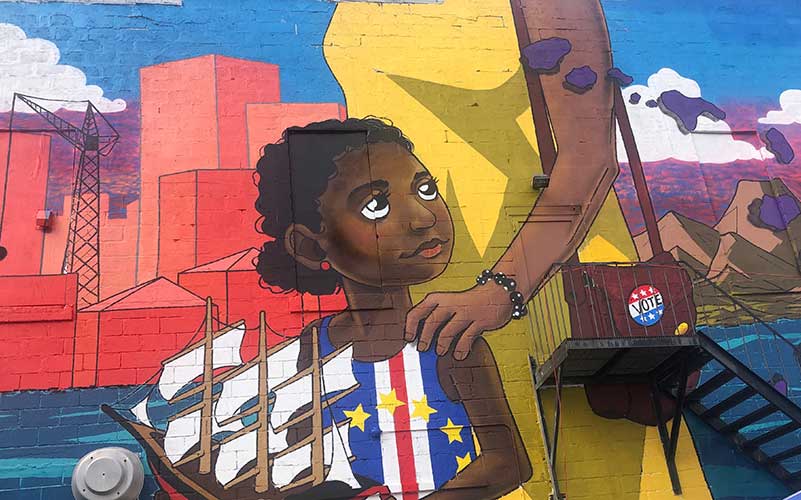
Turning research into action takes many forms – including this beautiful mural in New Bedford, which aims to instill community pride amongst the city's Cape Verdean population.
CLF’s Healthy Neighborhoods Study shows that health goes beyond one’s diet or exercise regime. A healthy community has engaged, active residents who believe they can influence changes in their neighborhood that directly impact their lives. In 2018, our data found that health is linked to social support, housing stability, and even civic engagement and community pride.
For the resident researchers who designed and conducted the study, the findings are deeply personal. They reveal trends about their hometowns and the ways that issues like gentrification and displacement are affecting their neighbors.
Now, those researchers and our local partner groups are taking the data gleaned from the Study and turning it into creative and unique action in their communities. In Chelsea and Everett, near Boston, and New Bedford, on the south coast, community activists are working to share the research results and raise awareness about the issues their neighbors said concern them most. The goal: to help shape a healthier future – one that activates their communities instead of erasing them.
Inspiring Engagement through Public Art
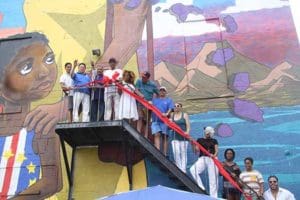
In a healthy community, everybody’s voices are heard. But in New Bedford, study site coordinator Gail Roderigues and resident researchers Dina Abreau and Karen Sikora noted in the data that residents born outside of the country had lower civic engagement than those born in the United States. As they thought about turning that data into action, they focused on helping the coastal city’s large Cape Verdean population understand that its voice matters, especially when it comes to housing and development.
They particularly wanted to reach young members of the Cape Verdean community. Working with the YMCA Southcoast, their goal was two-fold: to connect younger community members with their heritage and to help everyone feel that they can shape the future of their neighborhood. To accomplish their goal, they looked to public art.
Together, they planned a mural that could connect people across lands and generations. The finished piece, painted by local artist David Guadalupe, depicts a child looking up at her grandmother. The child clasps a toy ship, and a “VOTE” pin adorns her grandmother’s bag. The ship symbolizes the whaling legacy of New Bedford’s earliest Cape Verdean immigrants, while the overarching message encourages residents to vote as a way to protect their community’s future.
Debuted at a ribbon-cutting during the city’s annual Cape Verdean Independence Day celebration in July 2018, the mural connects the heritage and culture of the community with the painful realities of displacement and gentrification. Through this project, Roderigues, Abreau, and Sikora, with the help of the YMCA Southcoast, aimed to instill community pride and bridge the gap between residents and local housing decisions – an essential step toward helping to make their neighborhood healthier for everyone.
Connecting People and Ideas
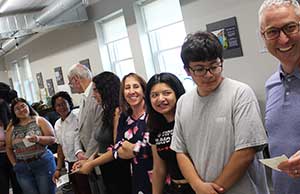
While resident researchers in New Bedford worked on cultivating community pride and spurring civic engagement, those working in Chelsea and Everett focused on spreading knowledge about gentrification and its impacts.
The research showed that people in both cities have lots of pride and love for their neighborhoods. Some residents see the neighborhood changes happening around them, and some do not. But even those that do lack access to information about the harmful effects of gentrification. They also do not feel a sense of control over these changes. While the residents knew through lived experience that displacement is a problem, they lacked the big data to help show the community and its leaders just how harmful it is.
To break down this knowledge barrier in Chelsea, the Environmental Chelsea Organizers (ECO), a team of teens working through GreenRoots, piggybacked on a series of workshops led by The Neighborhood Developers called the Chelsea Housing Games. The workshop series was designed to simulate the complexity of the housing process in the city, with specific emphases on displacement, developing housing, and the housing lottery.
At the third workshop in the series, ECO presented about their work on the Healthy Neighborhoods Study and its results. They then led small-group discussions to dive into more specific topics. Their ultimate goal was to prompt a larger community conversation around affordable housing.
Among the data they shared is that 86% of renters surveyed reported housing as a financial burden, compared to only 6% of homeowners. And 55% of renters expect to leave the neighborhood in the next five years. In addition, the majority of people who speak another language at home believe that changes to housing in Chelsea are not for their benefit.
While it’s common knowledge that displacement is happening in Chelsea, attendees were truly surprised by the data ECO presented. Now, armed with this new knowledge, residents can feel more empowered when community-wide discussions around affordable housing arise in the future.
A Spin of the Wheel Leads to In-depth Conversation
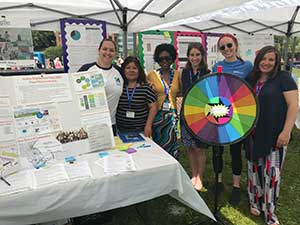
In neighboring Everett, resident researchers Josee Genty and Yrma Fiestas, along with site coordinators Kathleen O’Brien and Nicole Gaffam, set up a tent at the local YMCA Summer Kick-Off event. As members of Everett Community Health Partnership, their goals were to raise awareness about the research and showcase community pride, including why current residents enjoy living in Everett. They also wanted to spread messages about gentrification, encouraging their neighbors to use what they learn to inform policymakers about these widespread issues.
For Yrma, as with all of our resident researchers, this work is deeply personal. “It’s hard to watch people move because they like it here so much,” she says. Her desire to help people stay in Everett is what motivated her to join the Healthy Neighborhoods Study initially.
At the YMCA Summer Kick-Off, the team showcased a spin-the-wheel style game to “quiz” people about what’s going on in their community, using the study data as the answers. Their questions covered demographics, housing stability, health and happiness, and community changes. Participants enjoyed the game format, and it gave the researchers the chance to provide more context from the study’s findings. Their tent included posters with research data and informational flyers in multiple languages connecting residents to community groups and upcoming public meetings.
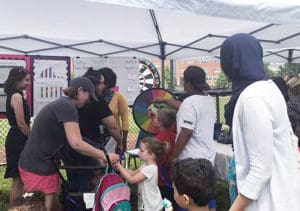
For many Everett residents, the data presented in the game was surprising, such as the answer to the question, “What percentage of people in Everett feel that changes to public greenspaces would not benefit them?” (Answer: more than 50%!) A long-time resident spoke with Yrma at length about the changes he’s noticed and asked how he could be involved. She pointed him to the flyers and resources available at the table and encouraged him to use his voice to advocate for what he wants to see.
He wasn’t the only one with this response. Overall, attendees were excited and curious to learn more and eager to share their own stories of housing or displacement.
Data into Action
In New Bedford, Chelsea, and Everett, the surge in real estate development has led to gentrification and displacement for residents. Our community partners, in collaboration with CLF and MIT, are working to change that. Whether through public art or informational games, resident researchers are starting conversations, working with knowledge, and activating their communities. The result: communities that can work together towards a healthier future.
This blog is one in a series about how our resident researchers are turning research into action. Read the entire series here.



